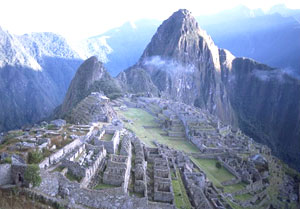|
|
|
|
Top Peru Destinations:
Lima hotels Cusco hotels Arequipa hotels Iquitos hotels Miraflores hotels See more hotels in Peru
World Destinations:
 Guides » Peru » Lake Titicaca - The Beauty Guides » Peru » Lake Titicaca - The BeautyLake Titicaca - The Beauty
Although there are many impressive lakes in South America, one stands out above the rest – Lake Titicaca. Bordering on the Bolivia and Peru borders, this massive lake is truly something worth seeing. Known as the world’s largest navigable lake, Lake Titicaca covers more than 3,800 square miles. Found at a summit, some 12,500 feet above sea level, the lake today is an important resource for people that live in this region.
While there are farmers and fishers living and working off the land, the lake is known for something else - the Uros people and their lives on floating islands. These islands are actually boats, each painstakingly made from the lake’s reed vegetation. Although the lake water is very cold, it still provides an abundance of fish. The main species includes the Orestias, which is also known as the Killifish, along with the Trichomycterus, otherwise known as the Catfish. Then in the 1930s, trout as introduced to Lake Titicaca and in the shallower waters, a huge frog called a Telmatobius lives. This particular species of frog can grow to a full food in length.  The water level of the lake fluctuates depending on the season with these fluctuations usually occurring over a cycle of several years. As an example, during the rainy season, which is the summertime running from December to March the lake waters rise. However, when the dry season approaches, which is the winter, the water recedes. At one time, people believed the lake was drying up very slowly but many recent studies have been performed, showing the lake only goes through cycles. The water level of the lake fluctuates depending on the season with these fluctuations usually occurring over a cycle of several years. As an example, during the rainy season, which is the summertime running from December to March the lake waters rise. However, when the dry season approaches, which is the winter, the water recedes. At one time, people believed the lake was drying up very slowly but many recent studies have been performed, showing the lake only goes through cycles.
The waters of the lake are limpid and slightly brackish. On the surface, average temperature is around 56 degrees but then as the water deepens to around 65 feet, temperatures will drop to around 50 degrees. Lake Titicaca has also undergone significant testing with the discovery that it is very rich in sodium, chloride, magnesium sulfate, and calcium sulfate. The depth of the lake is between 460 to 600 feet but the bottom slopes dramatically towards the Bolivian shore. At this point, the depth drops to an amazing 920 feet deep. To keep the water levels high, explorers have discovered over 25 rivers that dump into this lake. The largest of these is called the Ramis and the smaller called Desaguadero. The depth of Lake Titicaca is so vast that on certain days, you will even see waves just as if you were on the ocean. Lake Titicaca and the surrounding islands are said to be mystical and sacred. It was here that the Inca Empire lived and where today, various Indians still exist. All around the lake are more than 40 islands, some inhabited, even with semi-modern facilities. However, the majority of the islands are very pre-Colonial Peruvian with no electricity, running water, and infrastructure of any kind. The scenery is magnificent, something everyone going to Peru should experience. Last Updated: 10/19/2006 3:14:00 PM Mode articles for Peru What you find when visiting the country of Peru is multiple layers of civilizations. This among other things is what makes Peru such an interesting place to experience. For instance, there are a number of beautiful
What you find when visiting the country of Peru is multiple layers of civilizations. This among other things is what makes Peru such an interesting place to experience. For instance, there are a number of beautiful ... continue >>  Machu Picchu, also known as the lost city, is one of the world’s most spectacular ruins. If you want adventure when visiting Peru, then you must add this trip to the top of your list of things to do and see.
Machu Picchu, also known as the lost city, is one of the world’s most spectacular ruins. If you want adventure when visiting Peru, then you must add this trip to the top of your list of things to do and see.
... continue >>  Located in South America, the Andes Mountain stretches from the north to the south, going along the western coast some 4,500 miles, making this one of the longest and highest mountain ranges in the entire world. When
Located in South America, the Andes Mountain stretches from the north to the south, going along the western coast some 4,500 miles, making this one of the longest and highest mountain ranges in the entire world. When ... continue >> |
|
| | |
|
©2025 HotelsRu.com About us Privacy Site map Ancient and Current History of Peru |
|
 Look for deals on hotels?
Look for deals on hotels?